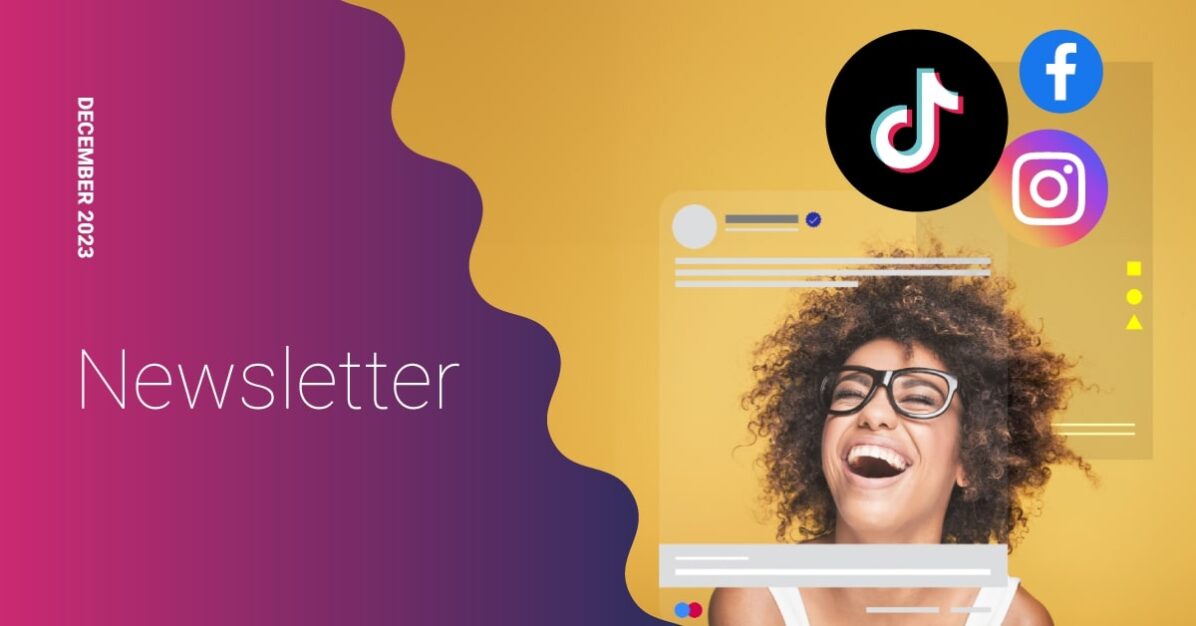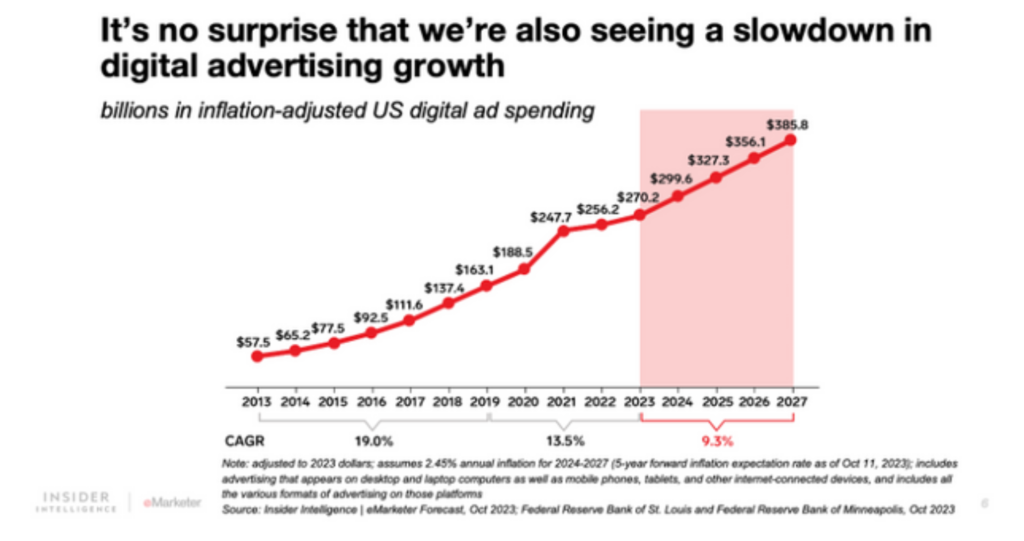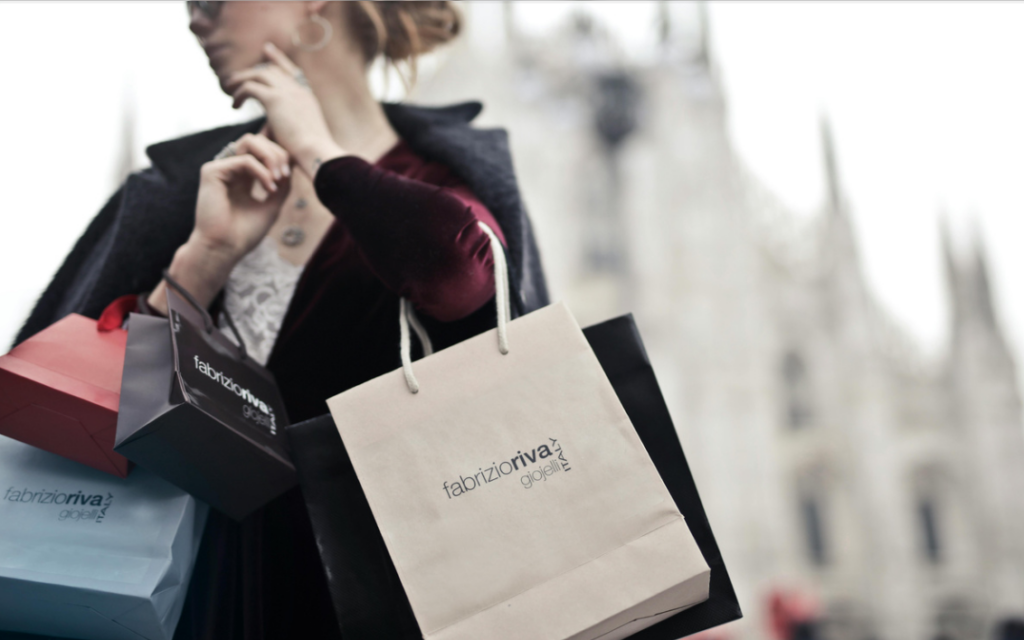AdParlor December 15 2023 Newsletter: Social Media Updates


AdParlor has curated our list of the top 5 digital advertising trends to watch in 2024:
#1: AI is Here to Stay
Artificial Intelligence is more than a buzzword, it’s the force behind the efficiencies developed in digital and social media advertising in 2023. However, we’ve only seen the tip of the iceberg as the largest transformations have yet to surface. Social platforms and adjacent technology companies everywhere are changing the ad landscape as we know it! 67% of marketers expect AI to have a “serious impact” over the next two years, and another 18% believe the change is already in progress. AI is expected to be leaned on heavily for media planning, creative ideation, audience targeting, and more.
- Meta: The Advantage Shopping Campaign (ASC) rollout in August of 2022 is among the most seasoned AI solutions in the paid social realm, but Meta has recently added generative ad copy and image enhancement tools to its AI suite. In 2024, Meta will roll out business messaging to streamline customer engagement and support.
- TikTok: In September, TikTok launched an AI Creative Assistant to improve video creation by providing insights on best practices, trends, and even brainstorming ideas.
- Pinterest: In September, Pinterest introduced an industry-first body type technology that uses AI to identify shape, size, and form in over 5 billion body type images in an effort to increase body representation on the platform. With this enhanced understanding of visual content, Pinterest has shaped its algorithms to increase representation of both body type and skin tone across search results and related Pins.
- Google plans to roll out generative search, which will transform the consumer experience and inevitably reduce long-tail publisher traffic. Google’s Performance Max (PMax) is an established AI ad product that serves ads across Google’s entire ad inventory in a single campaign, automating optimizations for budgets, bidding, audience and creative – ultimately empowering advertisers to meet their goals more efficiently. On average, advertisers see 18% higher conversion rates when leveraging PMax, but brand safety is still somewhat of a black box. After some initial mixed performance results and reviews by agencies of the ad product, newly added features like search themes and branded keyword exclusions have given advertisers more confidence in relinquishing control to Google’s AI solutions.
- Sources:
- How Google’s AI Ads Take Control Of Brands’ Strategies
- The Future of Digital 2024
- Advertising Trends to Watch in 2024
AdParlor POV:
Many of AdParlor’s clients have seen success leveraging Meta’s tried-and-true ASC solution. An ecommerce giant client of ours saw a 20% Y-o-Y increase in ROAS this Cyber 5 period, with success attributed to ASC campaigns. The ability to control campaign delivery to new vs. existing customers ensured the ecom brand’s customer acquisition goals were also met. The unique structure of ASC campaigns allows Meta’s algorithm to reach a broader audience of high-intention customers while maintaining cost efficiencies, often outperforming business-as-usual dynamic programs. As more platforms expand into AI functionality, it’s important to monitor AI-driven campaigns and be prepared to iterate based on performance data. Methodical testing frameworks such as A/B Testing (e.g., AI-driven ad targeting vs. manual targeting) and Incrementality Testing are recommended to accurately assess the true impact of AI campaigns.

#2: Expect Modest Digital Growth in 2024

Insider Intelligence predicts that digital ad spending growth rates will reach its lowest levels in years by 2027. Moderate growth of 13.6% is expected in 2024 before declining to 11% by 2027. Factoring out the anomalous year of 2021, when digital ad spending spiked amid pandemic lockdowns, digital ad spend has been on a gradual downward trajectory since 2019. Digital has been pulling ad spend share from other channels, such as linear TV, for years but the market is maturing to a state where there are fewer places to pull additional spend from, though the overall digital market remains healthy. Advertisers are also incorporating more omnichannel strategies with mixed media formats compared to a few years ago.
Time spent on social media platforms is also reaching a similar point of maturity after a 6.8% growth over the past four years. As we’ve recapped in previous newsletters, TikTok continues to dominate the social platforms in terms of average minutes spent per day, despite seeing a modest dip in 2023. However, we expect TikTok’s push for longer-form content to bolster time spent in the app. Facebook also saw small Y-O-Y decreases while Instagram maintained small, but sustainable, growth. Meta aims to increase time spent on their platforms with Threads, although this is not proving to be the golden goose the company was hoping for as it struggles to drive adoption and engagement.

AdParlor POV:
While overall digital ad spend growth may be slowing down, the space is healthy and ripe with opportunities to maximize digital media performance. Consumer shopping habits have shifted online, notable in the massive shift from Linear TV to Connected TV. CTVs is a growing trend combining the ease of online advertising and reach of TV. Tailored, skippable ads can be served to target audiences while they are streaming video content on their TVs. At current pace, CTV ad spend is expected to grow to $40.9 billion by 2027.
Online consumers expect both tailored content and a seamless shopping experience today. By 2027, consumers will spend one in five dollars online. In 2023, just 15.6% of retail sales were e-commerce in the US, while China had 45.9% e-commerce sales and the UK had 29.6%, displaying an enormous growth opportunity for the country. The e-commerce sales opportunity pairs nicely with the improvements in digital storefronts on the social platforms that are also helping drive discovery.
- In September, TikTok launched TikTok Shop, just in time for brands to take advantage of the peak holiday shopping period. Brands like Tarte Cosmetics and Cider sold out of products on Black Friday by promoting deep discounts on TikTok Shop.
- In November, Meta and Amazon streamlined the customer experience as users on Facebook and Instagram can now shop from Amazon without leaving the social platforms. In addition to an improved user experience, the customer journey will allow for better data tracking and enhanced targeting capabilities in the future.
As user growth has slowed across some of the social platforms, 2024 will be a strategic time for brands to diversify their digital strategies. A diverse social media mix across platforms will offer marketers increased chances to tap into previously undiscovered audience potential. While Meta continues to hold the majority of the advertising share, TikTok, Pinterest, YouTube, X, Snapchat, and Reddit open the doors to unduplicated user bases that can help supplement your performance goals.

#3: Down to its last crumbs— farewell to the cookie
We’ve heard this story before – the cookie is being phased out, and advertisers need to find new tracking alternatives before the clock runs out. While Google intended to phase out cookies in early 2022, they’ve been repeatedly pushing the cookie’s expiry date to ensure new, privacy-first alternatives have enough time to be properly developed and tested. These identifiers are finally slated to be depreciated in 2024 – and this time, Google means it. A problem that remains is adoption – approximately 25% of advertisers continued to use cookie-based pixel tracking as of Spring 2023, leaving many unequipped for the impending changes. Insider Intelligence predicts that the death of cookies will finally force the volume of identity providers, who have been selling deterministic, probabilistic, and contextual ID services, to shrink substantially. It is also predicted that Apple will use this as an opportunity to roll out a DSP in an effort to become a bigger player in the advertising space.
(Source)
AdParlor POV
As the cookie takes its final farewell, it is mission critical to adopt server-side tracking to collect more complete, accurate data and improve ongoing performance.
Utilizing more first-party data, contextual targeting, and innovative technologies like AI will also provide valuable insights without heavy reliance cookie-based signals. As we experienced in the Apple ATT prompt aftermath, marketers need to adapt to a privacy-centric advertising landscape that may require changing up your advertising strategy and resetting performance expectations. While there are still some questions around AI ethics and consumer privacy, we believe AI will help balance the loss of cookie data and open up a lot of opportunities for brands.

#4: Walled gardens will fall as RMN spending booms
Walled gardens will start to see a decline in ad spend this year, particularly as Retail Media ad spending continues to grow and becomes one of the fastest growing channels we’ve seen in recent times. We’ve already seen a few walled gardens partner up with larger companies to better support their ad businesses – X (Twitter) teaming up with Google Ads Manager; Meta, Snapchat and Pinterst striking collaboration deals with Amazon. Insider Intelligence predicts that this trend will only continue, with platforms like Reddit, potentially following in their footsteps, forging new alliances to support advanced first-party data and/or commerce data targeting.

AdParlor POV:
This evolving landscape of ad spend signals a notable shift. As walled gardens will likely witness a major downturn in ad investment, RMN’s emerge as a rapidly expanding avenue for advertising. This is also paving the way for platforms to, out of necessity, develop more robust advertising capabilities. What this presents is the possibility of a future where partnerships foster more effective targeting strategies. And as we increasingly expect to see platforms developing new partnerships, we are urged to diversify our own strategies, embrace new and emerging channels, and find ways to best leverage up and coming data-driven partnerships.
Source: eMarketer: Advertising Trends to Watch in 2024 & The Future of Digital 2024
How Google’s Ai Ads Take Control Of Brands’ Strategies By Emma
#5: Creative is the new Targeting
We all understand the importance of utilizing strong creatives for impactful campaigns that convert. As AI evolves to simplify complex campaign setups and granular targeting practices, creative is the new targeting. Creative will be the most powerful toggle marketers can use to optimize campaign performance. According to a Magna study, creative quality impacts purchase intent by over 56%. Nielsen studies report that creative is responsible for 65% of sales lift. These studies validate the ever-increasing importance of investing in creative development. Determining creative efficacy requires diving deeper into the various elements of an ad’s message – dissecting everything from the CTA, ad setting (ie: indoors or outdoors), color intensity, and even the position of any person(s) or objects featured in the image or video. This kind of granular creative data, powered and distributed by up and coming AI tools, can be contextualized by marketers and applied to future creative, ensuring the elements responsible for the desired lift are front and center.
AdParlor POV
More data is almost always better. Strapped with an expansive range of high quality data (emphasis on high quality), we can gain a unique competitive edge that allows us to make more informed decisions that translate to increased performance. For creative data, we’re seeing AI-based tools such as Vidmob Analytics, Rocketium, and Quantcast building out new offerings to provide qualitative information on how the various elements of a given creative contributed to overall performance.
For example, Vidmob’s “Creative Analytics” can analyze impressions to test a given set of creative questions, like whether showing a phone in use resulted in increased conversions. These types of data points on creative elements can then be translated and analyzed with both context and expertise on our side, to better inform creative development and refine our media to align with what our core audience responds to most, ultimately boosting sales and ROAS. AdParlor is a founding partner of VidMob’s Agency Partnership Program that allows us to empower brands by allowing us to:
- Set new standards for always-on campaign effectiveness and offer new innovation, collaboration and oversight for marketing and creative teams
- Employ cutting-edge AI and ML technology to connect creative to economic impact by offering precise guidance on maximizing ad spend
- Implement fully data-driven campaign execution and operations with the ability to measure the impact of creative edits through media and analytics teams

How TikTok’s Move to Long-Form Video Content Could Impact the Creator Landscape
TikTok is embarking on a significant shift by extending its renowned short-form video platform to now include longer videos. The decision to test 15-minute uploads represents a strategic adaptation to cater to evolving user preferences and changing content consumption habits. This move opens up fresh possibilities for creators, granting them greater flexibility to delve into more detailed narratives and engage audiences on a deeper level. Initially limited to 15-second videos, TikTok's venture into long-form content raises questions about how creators will utilize the extended time.

The exploration of lengthier content also prompts consideration of user acceptance and the broader implications this shift holds for TikTok’s competitive standing within the social media landscape.
AdParlor POV
TikTok, known for its dynamic approach to feature testing, continues to evolve in response to its community’s dynamic needs. The introduction of longer-form videos presents a myriad of opportunities for creators:
- Expanding Creator Diversity: This move allows creators native to platforms like YouTube and Twitch to share their long-form content on TikTok, potentially broadening TikTok’s market share within the larger creator community. We may see an increase in verticals that have historically performed well with long-term content, including tech, gaming, beauty, and cooking.
- Empowering TikTok Creators: Native TikTok creators now have the chance to experiment with different video lengths, aiming to foster deeper connections with their audiences and enhance overall view times.
- Innovative Partnerships with Advertisers: The extension to longer videos opens doors to dynamic partnerships between creators and advertisers. With an anticipated rise in long-term paid collaborations on TikTok, advertisers can explore dedicated and product integration videos—a realm historically dominated by platforms like YouTube and streaming services.
The platform’s pivot to long-form video content not only accommodates diverse creator styles but also sparks new possibilities for partnerships and content strategies. The unfolding narrative promises exciting opportunities for creators and advertisers alike, as TikTok continues to redefine the boundaries of digital expression.
If you are looking to unlock growth and grow your business, we can help! Let’s chat
About AdParlor
AdParlor, an agency established in 2008 and now a division of Fluent (NASDAQ: FLNT), is a leading provider of data-driven digital media strategy and execution that unlocks explosive growth for world-class and disruptive brands. Through our GrowthFuel framework we offer proprietary performance marketing solutions that have scaled our clients’ programs profitably, with our clients’ success being our sole agenda. Our custom technology solves problems related to creative insights, creative production, real time cross-platform reporting and more. Brands choose AdParlor because our unmatched expertise in ecommerce digital media delivers impactful full-funnel performance campaigns for profitable growth.